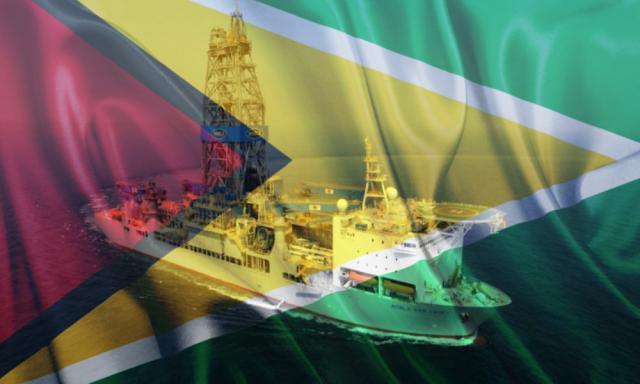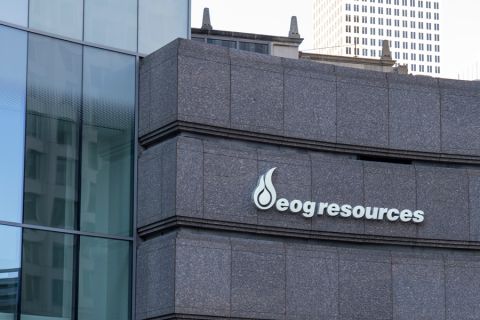
The Noble Sam Croft drillship is among the vessels used during operations on the Staborek Block offshore Guyana. (Source: Hess Corp./Shutterstock/Hart Energy)
Partners in the Exxon Mobil Corp.-led consortium offshore Guyana have increased the resource estimate on the prolific Stabroek Block by another billion barrels to about 9 billion barrels of oil equivalent (Bboe).
Previously, Exxon Mobil and partners Hess Corp. and CNOOC Ltd. put estimated recoverable resources of the Stabroek Block at more than 8 Bboe.
Speaking on an earnings call on Oct. 28, Hess Corp. CEO John Hess said up to 10 FPSOs could be needed to develop the resource base on the block where 18 discoveries have been made, the latest of which was the Redtail-1 well in September.
“In terms of preserving the long-term value of our assets, Guyana—with its low cost of supply and industry leading financial returns—remains our top priority,” Hess said on the call.
Guyana continues to be a bright spot during a challenging time for the oil and gas sector, which has slashed budgets—including for exploration—as the coronavirus pandemic impacts demand. Operations offshore, particularly in the Gulf of Mexico (GoM), are also being hammered by an active hurricane season.
RELATED: Hess Posts Wider-than-expected Quarterly Loss
Like its peers, Hess has cut its E&P budget, down 40% to about $1.8 billion, with relentless focus on driving down costs and breakevens.
Breakevens range from about $25/bbl Brent at the Liza Phase 2 development to about $35/bbl at Liza Phase 1, which started production last year, Hess has said. The $9 billion Payara, sanctioned in late September, has a breakeven of about $32/bbl.
“We continue to execute our strategy and achieve strong operational performance while prioritizing the preservation of cash, capability and the long-term value of our assets during this low-price environment,” Hess said in a news release. “Our differentiated portfolio of assets, including multiple phases of low-cost Guyana oil developments, positions us to deliver industry-leading cash flow growth and drive our company’s breakeven price to under $40 per barrel Brent by mid-decade.”
The increased resource estimate on Oct. 28 reflects results of the Uaru, Yellowtail-2 and Redtail-1 wells, Hess COO Greg Hill said on the call. All three discoveries were announced this year. Uaru-1 encountered about 94 ft of high-quality oil-bearing sandstone reservoir. Yellowtail-2 hit 69 ft of net pay in a new reservoir, while Redtail hit about 232 ft of oil, according to Exxon Mobil, the operator.
Regarding the potential for up to 10 FPSOs to develop resources, Hill reminded analysts on the call that “we still have multimillion barrels of upside that hasn’t been explored or appraised.” Results would determine whether new hubs are needed. The partners are utilizing the design one, build many concept for the FPSOs.
“There is more upside coming on top of that number,” Hill added, referring to the 9 Bboe resource estimate and later pointing to other geological layers such as the Santonian. The Santonian is 3,000 ft deeper than the Campanian, where most of the resources have been found on the block.
“If you look at it on seismic, the extent of the channel system is as extensive or more extensive than the Campanian,” Hill said. “The industry has got five penetrations in it—two on Stabroek and three in Suriname obviously on Apache’s block. So, that will be subject of a lot of exploration and appraisal drilling over the next couple of years.”
The next planned exploration well on the block will target Campanian-age reservoirs about 30 miles east of the Liza Field, he said. The well is expected to spud by year-end with results in first-quarter 2021.
Exploration efforts continues as work progresses at Liza Phase 2 and Payara. With about 80% of the topsides, hull and subsea work is complete, Liza Phase 2 is on track for first oil by early 2022. Partners plan to reach first oil at Payara, which will have 41 wells, in 2024.
The Greater Yellowtail area appears to be next in line, according to executives.
A drillstem test is also planned for Redtail during the fourth quarter and work continue toward completion of the natural gas injection system commissioning at Liza Phase 1. Once complete, it will enable the Liza Destiny FPSO to reach nameplate capacity of 120,000 gross bbl/d in December.
“It is important to note that the delays in commissioning the gas injection system are mechanical in nature and the reservoirs and wells continue to deliver at or above expectations,” Hill said.
Gross production from Liza Phase 1 averaged 63,000 bbl/d during the third quarter.
Hess expects to begin generating free cash flow from its Guyana assets within a few years, according to CFO John Rielly. Hess’ decision to sell its 28% working interest in the deepwater GoM Shenzi Field to field operator BHP Group Ltd. for $505 million will help fund developments in Guyana.
“As [Liza] Phase 2 comes online, our operations in Guyana will begin to generate free cash flow for the corporation, even in a $40 oil price environment,” Rielly said. “And depending on commodity prices at that time, the corporation will begin generating free cash flow between 2022 and 2024. As we generate free cash flow, we plan to first reduce debt and then increase returns to shareholders.”
Recommended Reading
EOG Resources Wildcatting Veteran Billy Helms to Retire
2024-04-02 - Joining an EOG Resources predecessor in 1981, Helms is among the pre-1986-oil-bust generation who later found success in shale.
The One Where EOG’s Stock Tanked
2024-02-23 - A rare earnings miss pushed the wildcatter’s stock down as much as 6%, while larger and smaller peers’ share prices were mostly unchanged. One analyst asked if EOG is like Narcissus.
CEO: Magnolia Hunting Giddings Bolt-ons that ‘Pack a Punch’ in ‘24
2024-02-16 - Magnolia Oil & Gas plans to boost production volumes in the single digits this year, with the majority of the growth coming from the Giddings Field.
Magnolia Oil & Gas Hikes Quarterly Cash Dividend by 13%
2024-02-05 - Magnolia’s dividend will rise 13% to $0.13 per share, the company said.
E&P Earnings Season Proves Up Stronger Efficiencies, Profits
2024-04-04 - The 2024 outlook for E&Ps largely surprises to the upside with conservative budgets and steady volumes.






